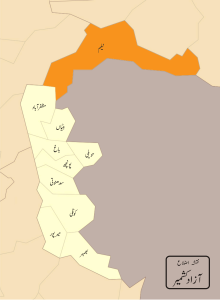MIRPUR
Mirpur (Urdu, Punjabi: مِيرپُور or more commonly known as New Mirpur City) is the capital of Mirpur district and is one of the largest cities of Azad Kashmir. The city itself has gone through a process of modernization, while most of the surrounding area remains agricultural. Mirpur is known for its grand buildings and large bungalow-houses primarily funded through its ex-patcommunity, which comes mainly from the United Kingdom, Europe, Hong Kong, Middle East and North America. The main crop cultivated during summer is millet and pulses. However, there are places where other crops such as wheat, maize and vegetables are also grown. The produce of quality rice from the paddy fields of khari Sharif between Upper Jhelum Canal and Jhelum river are very famous and popular for its aroma and taste. The production of electricity, through Mangla Dam makes this district somewhat unique in the entire region which provides energy needs for Azad Jammu and Kashmir and Northern Punjab province.
A significant portion of the population from the district migrated to the United Kingdom in mid to late 1950s and in early 1960s – mostly to West Yorkshire, East Midlands, West Midlands, Luton, Peterborough, Derby and East London. 70% of the British Pakistanis are Mirpuris. For this reason Mirpur is sometimes known as "Little England". Many products from the UK are found in this city. Many shops in the city accept the Pound sterling.
Chowk Shaheedan
HISTORY
The area that is now Mirpur has always been a crossroad for major invasions of the South Asia and has formed part of various empires over time including the role of an outlying region of the conquests of Alexander the Great, the Kingdom of Gandhara, the Mauryan empire, the Kushan empire, the Sultanate of Ghazni, the Delhi Sultanate and the Mughal empire amongst others.
The Mirpur city itself was founded in around 1642 AD or 1052 AH by the Ghakhar chief Miran Shah Ghazi. The Imperial Gazetteer of India Provincial Series Kashmir and Jammu (1909) provides this information about Mirpur history as "it is said to have been founded by Miran Shah Ghazi and Sultan Fateh Khan". An alternate view is that the city was founded by Mira Shah Gazi and Gosain Bodhpuri, both regarded as saints. The word 'Mir' was taken from the name of the former while 'Pur’ from the latter.
MIRPUR MAP
In 997 CE, Sultan Mahmud Ghaznavi, took over the Ghaznavid dynasty empire established by his father, Sultan Sebuktegin, In 1005 he conquered the Shahis in Kabul in 1005. The Delhi Sultanate and later Mughal Empire ruled the region. The Punjab region became predominantly Muslim due to missionary Sufi saints whose dargahs dot it's landscape
The area that is now Mirpur has been historically associated with Pothohar. Though modern demarcation of Potohar devised by British excludes Mirpur by using Jhelum river as the eastern boundary. By the end of the 18th century, Gakhar power in Pothohar had declined. Mirpur had become part of Chibb ruled state of Khari Khariyali with capital at Mangla Fort. With the rise of Sikh power in Punjab, Maharaja Ranjit Singh established his supremacy and set his eyes on the Chibh states of Bhimber and Khari Khariyali. In 1810, a force was sent against Raja Sultan Khan of Bhimber and was met with fierce resistance. However, in 1812 another Sikh army under prince Kharak Singh defeated SultanKhan and the Bhimber state was annexed as Jagir of Kharak Singh. Around the same time, Ranjit Singh acquired Gujrat and invaded Khari Khariyali ruled by Raja Umar Khan. Raja Umar Khan made peace with Ranjit Singh. But before a settlement could be made, he died and the state and Mirpur became part of Ranjit Singh's territories.
In 1816, Ranjit Singh annexed Jammu state and in 1820 awarded Jammu to his commander Gulab Singh who hailed from Jammu and was under the service of Ranjit Singh for the past eight years. Between 1831–39 Ranjit Singh bestowed on Gulab Singh the royalty of the salt mines in northern Punjab, and the northern Punjab towns including Bhera,Jhelum, Rohtas, Mirpur and Gujrat. Gulab Singh kept on expanding his kingdom and in 1840 Baltistan was made subject to Jammu and Gilgit fell to a Sikh force from Kashmir in 1842. The state of Kashmir was annexed by Ranjit Singh in 1819. However the rebellion in Hazara in the beginning of 1846, compelled the country to be transferred to Raja Gulab Singh of Jammu as well. As an aftermath of the First Anglo-Sikh War and the Treaty of Lahore, The Treaty of Amritsar was signed between the British Government and Raja Gulab Singh of Jammu on March 16, 1846. The British Government sold Kashmir to the Raja of Jammu for 75 lakhs Nanak Shahi Rupees. This treaty transferred him all the hill states between Ravi and Indus. The transfer included Kashmir, Hazara and the southern hill states (including former Khari Khariyali Thus sealing the fate of Mirpur with the new state of Jammu and Kashmir.















